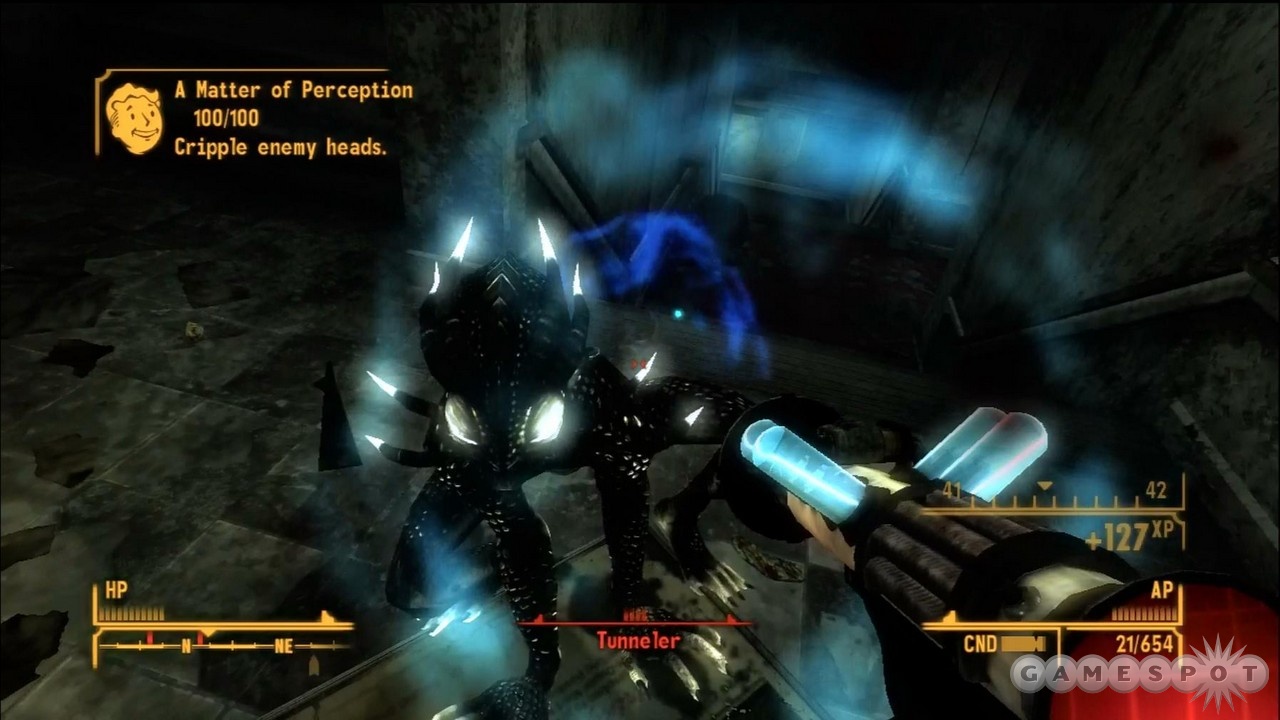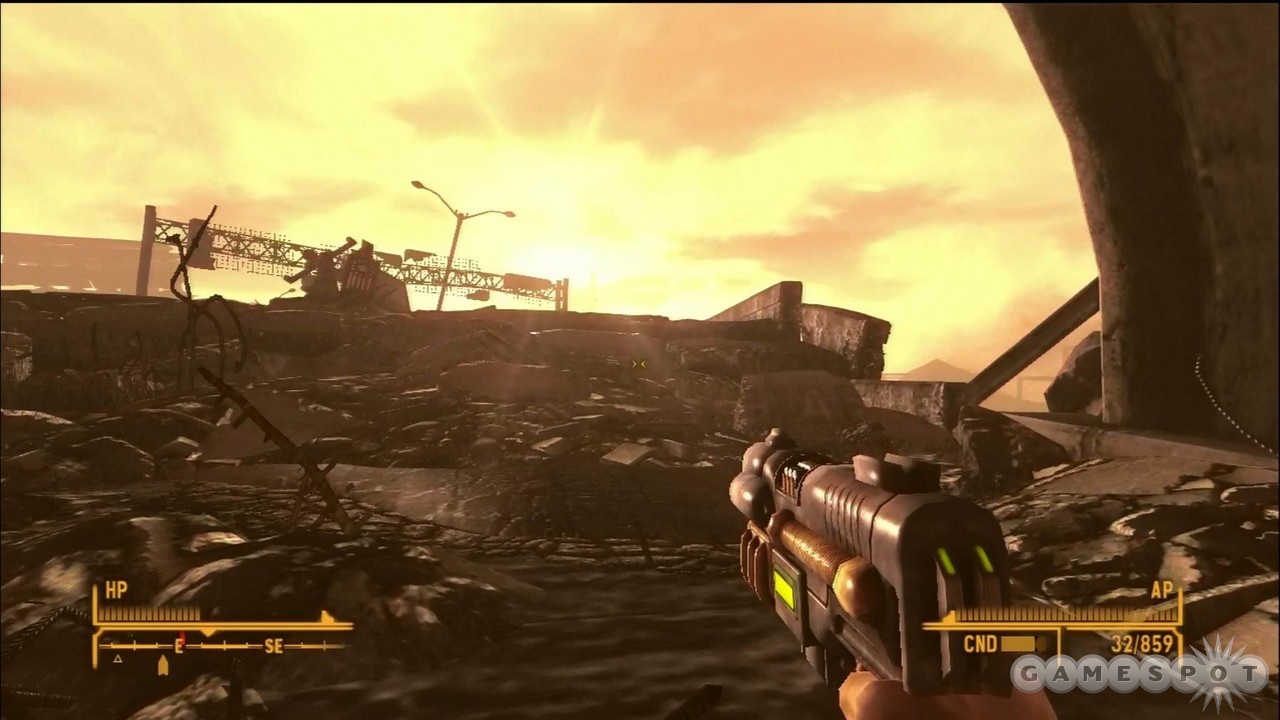Fallout: New Vegas - Lonesome Road is aptly named because the path you travel through this linear add-on is a solitary one. Your sole companion is a hovering robot that speaks in bloops and bleeps, though your adventure isn't devoid of human connection. This robot--ED-E is its name--also serves as a conduit of both the present and the past. In the present, a fellow courier named Ulysses growls solemnly at you through ED-E, tantalizing and annoying you with piles of vague, oblique dialogue. Meanwhile, snippets from the past tell you of ED-E's creation and creator. This narrative structure is thematically relevant: Lonesome Road is about the faded memories of the past and how they affect the choices you face in the here and now. It is an unusual adventure, more scripted and less open ended than you might have expected, but it's dotted with the kind of signature moments that Fallout: New Vegas typically lacked. This is the last of the game's downloadable adventures, and it's entertaining on its own terms, if not an expansive and explosive conclusion to the New Vegas tale.
Ulysses is a former scout and a witness to the nuclear disaster that wiped the residents of a community called The Divide off of the map. He is the sole survivor, and intrigued by the influence one person can wield over individuals, communities, and continents. You are that person. In Lonesome Road, you piece together your unremembered past from Ulysses' nebulous dialogue. "You carry death wherever you go--if the Mojave doesn't know it yet, it will," he grumbles. "I carry no hatred for duty…if that's what this was. The Divide was more than that. Its people, more than that." Such vagueness serves the tale well at first, spurring you on to learn more about the land and your connection to it. In time, however, Ulysses' ramblings wear thin. What initially sounds like pearls of wisdom turns to chunks of gravel coughed up by a writer padding out a script with the same basic notions worded in 1,001 convoluted ways. And when the conclusion arrives, no matter which ending you experience, you won't likely walk away feeling like you learned much from Ulysses' winded monologues.
It's telling that the eyebot ED-E, with his (or her?) wordless communication, is ultimately a more engaging character than the one who elaborates on nothing at all for countless minutes. You speak with ED-E from time to time, and like some other wordless robots in the wasteland, you can understand his gobbledygook. Exaggerated motions and electronic whines make ED-E's emotions (or whatever emotion-like attributes robots have) immediately clear. This bot is actually a clone of the robot with the same name that appears in the main game and was built by one Doctor Whitley, who was as much of a mentor to ED-E as he was a creator. Through Whitley's voice logs, you learn that ED-E longs to be like Ralphie, a bot that was a central figure in a prewar television show. ED-E is fiercely loyal and difficult to dislike, and a few different story moments focused on him might pull at your heartstrings.

With ED-E (usually) at your side, you journey through The Divide, seeking Ulysses--and answers. Lonesome Road is structured differently from most Fallout adventures. There aren't wide-open areas to investigate, and there are few side quests to pursue. And what side missions do exist aren't terribly compelling: detonate the warheads scattered about the land, collect audio logs, and so forth. Without the openness of typical Fallout regions, you get few chances to exercise the power of choice. You might pick locks and hack computers, but in these linear environments, you never feel as though you have solved a challenge by indirect means when you do so. That doesn't mean there aren't choices to make: The concluding sequence offers you a chance to exercise great power or to refuse the opportunity entirely. But the organic decision making for which New Vegas is known is mostly absent here.
Lonesome Road still makes a mark, if not for adhering to the franchise's strengths, then for wisely using its linearity by making good use of a number of scripted events. An explosion in the sky and the resulting mushroom cloud is a fearsome sight to behold. An elevator ride turns into a battle for survival, featuring one of the add-on's new enemies: bug-eyed underground dwellers called tunnelers. Earthquakes shake the ground as you trudge through a burning complex. Grabbing loot from within a rusted vehicle might cause a deathclaw to land on the roof with a thud. These predetermined occurrences may not seem very "Fallout," but they prove effective nonetheless. This is in part due to the evocative environments in which they take place: a crumbling overpass illuminated by a glowing yellow sky, the slanted corridors of collapsing buildings, and so forth. But your travels are not without their frustrations, which usually come in the guise of all-but-invisible mines that you step on frequently. They're a ridiculous irritation that make the journey less fun than necessary.

And what would the new Fallout be without the glitches and execution blunders that so frequently intrude on your travels? A tunneler might clip into the environment, following you around and attacking you from beneath the ground. (Contrary to what the creature's name might imply, this is a bug, not a feature.) A rock hovers in the sky as if dangling from an unseen thread. Invisible walls prevent you from vaulting over obstacles you should be able to clear. These returning issues become less and less forgivable as time and technology march forward. Fortunately, this adventure's key developments help overshadow them, as do some new weapons (a rocket launcher called Old Glare among them), a level cap increase, and other goodies. Nevertheless, Fallout: New Vegas - Lonesome Road doesn't fully satisfy. The confined environments make for unexceptional exploration, and the long-winded dialogue never reaches a proper climax.